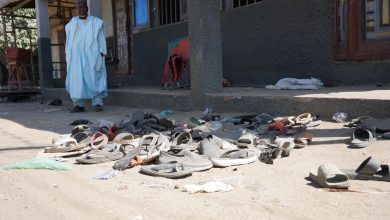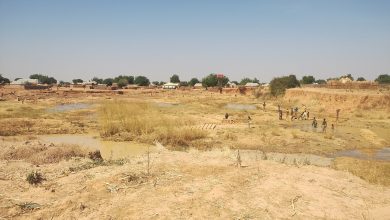Zamfara’s Gold Veins Focus Of Unabated Violence

Buried beneath Zamfara’s topsoil are gold veins bearing wealth that have brought riches to few as well as misery, sickness and death to many families. The gold rush has also had a devastating impact on biodiversity in mining areas.
Nigeria’s top security adviser is scheduled to meet intelligence chiefs and ministers to discuss the nexus between illegal mining and unabated violence in Zamfara, almost two years after the government banned gold mining and subsequently lifted the ban in 2020.
On Thursday, the Presidency announced that the National Security Adviser (NSA), Maj.-Gen. Babagana Monguno (Rtd), would convene a meeting with the heads of the country’s domestic and foreign intelligence agencies as well as the ministers of Defence, Interior and Mines and Steel Development.
According to a government statement, the security meeting on illegal mining and the crisis in Zamfara is coming after a directive was given by President Muhammad Buhari to the NSA “to ensure that there is a clear pathway to ending the resurgent banditry in Zamfara State, which has continued to cost lives and the displacement of thousands of families from their towns and villages.”
The meeting is expected to also address corruption, government oversight and lawlessness.
Zamfara Gold Veins and Violence
In Thursday’s statement, the government said beyond the problems of bandits and cattle rustlers, the scale of lawlessness had been aggravated by illegal miners who were harvesting resources they had no legal right to exploit.
The Senior Special Assistant on Media and Publicity to the President, Mallam Garba Shehu, was quoted as saying that the president’s order was in response to a message from the Speaker of Zamfara State House of Assembly, Nasir Magarya, calling on him to intervene and stop the incessant killings.
Zamfara lies in a geological area where one of the most important gold occurrences are found in Nigeria, with places such as Maru, Anka, Malele and Maradun local government areas at the heart of the gold-bearing quartz vein.
Artisanal and illegal mining has played a significant role in the exploration and extraction of gold despite the hazards and risks involved in the practices.
This is largely due to the prospect of an alternative source of income, escaping poverty and finding wealth alongside the neglect of the mining sector in favour of the black gold in the Niger Delta region as well as the absence of big mining corporations in the country.
The unregulated and unsafe artisanal gold mining and processing in Zamfara State have fuelled lead poisoning and contamination crisis in communities.
In March 2010, Médecins Sans Frontières (Doctors Without Borders) was alerted to a high number of child fatalities in Zamfara State, where an estimated 400 children died.
Doctors Without Borders reported that laboratory testing later confirmed high levels of lead in the blood of surviving children.
In the past few years, the government has renewed interest in mining activities in the state to encourage large scale mining and regulate and monitor gold trade and transactions as a result of growing concerns over the security risks illegal and artisanal mining pose to the country.
An uproar over resource governance followed Zamfara State Governor Bello Muhammad Matawalle’s disclosure of a N5 billion partnership with Nigeria’s apex bank, Central Bank of Nigeria, to supply gold. The disclosure was made after the government lifted the ban on mining in Zamfara State, citing surveillance efforts to curb illegal mining and interest from genuine investors.
In April 2019, the Inspector-General of Police, Mr Mohammed Adamu, while briefing State House correspondents in Abuja, announced the banning of mining in Zamfara State.
Adamu said the government took the decision because it found out that there was a relationship between bandits attacking the state and illegal miners.
Despite the security impact of unregulated mining in Zamfara, the sector provides thousands of people with income thereby reducing the effect of crushing poverty and vulnerability of recruitment by criminal groups.
The violence in Zamfara is complex with historical, social, economic and environmental drivers mutually reinforcing each other to sustain rural banditry, kidnapping, cattle rustling, revenge killing and the battle for control of neglected spaces and resources such as livestock, land and water.
Insufficient and weak law enforcement and the criminal justice system have encouraged vigilantism, intimidation and extrajudicial measures among warring groups.
A previous review of the violence in the state revealed that between 2011 and early 2018, 1,321 people were killed, 1,881 persons injured and 185 cars and motorcycles were lost. Within the same period, over 10,000 cattle were rustled with 2,688 hectares of farmland and 10,000 houses destroyed.
The violence over the years has resulted in deep enmity, suspicion and hostilities between the mostly Hausa farming communities and Fulani pastoralists.
The crisis has encouraged a spike in kidnapping for ransom as armed groups abduct people from their homes and intercept travellers in recent years.
The government at the federal and state levels has adopted both military strategies and dialogue to end the crisis but little progress has been made. The proposed security meeting is one such efforts, and experts say and hope it yields desired results.
Support Our Journalism
There are millions of ordinary people affected by conflict in Africa whose stories are missing in the mainstream media. HumAngle is determined to tell those challenging and under-reported stories, hoping that the people impacted by these conflicts will find the safety and security they deserve.
To ensure that we continue to provide public service coverage, we have a small favour to ask you. We want you to be part of our journalistic endeavour by contributing a token to us.
Your donation will further promote a robust, free, and independent media.
Donate HereStay Closer To The Stories That Matter




